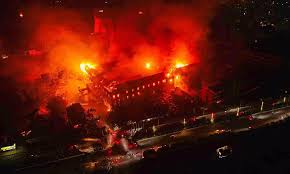Kathmandu, Sept 10: Nepal is witnessing an alarming wave of unrest and violence, plunging the Himalayan nation into chaos. Reports from across the country indicate widespread arson, looting, and targeted attacks, raising fears of a prolonged crisis.
The situation escalated dramatically after several jails were stormed by rioters, leading to the escape of more than 1,000 inmates, many of them convicted extremists. Authorities confirmed that among those on the run are high-risk prisoners linked to violent groups, heightening concerns over national security.
Adding to the turmoil, the iconic Pashupatinath Temple in Kathmandu, a UNESCO World Heritage Site and one of the holiest Hindu shrines, came under attack. Though the extent of damage is still being assessed, the incident has sparked outrage among religious communities and citizens at large.
The death toll has continued to climb amid the violence, with at least 25 people reported dead so far. Hospitals are struggling to treat the injured as clashes between mobs and security forces intensify. Residents in several districts described the scenes as “lawless,” with shops torched, public transport halted, and essential services disrupted.
Political observers likened the current disorder to the anarchic episodes seen in Bangladesh in recent years, where violent street agitations spiraled into large-scale destruction. The resemblance, they warn, is a cautionary signal of how unchecked unrest can destabilize an entire region.
Security agencies have been deployed in full force, yet the scale of the uprising has overwhelmed local police. The government has urged calm and appealed to citizens to cooperate in restoring peace, but confidence in state machinery remains shaken.
As Nepal grapples with this crisis, the international community is closely monitoring developments, fearing that instability could spill across borders and trigger wider geopolitical consequences.










